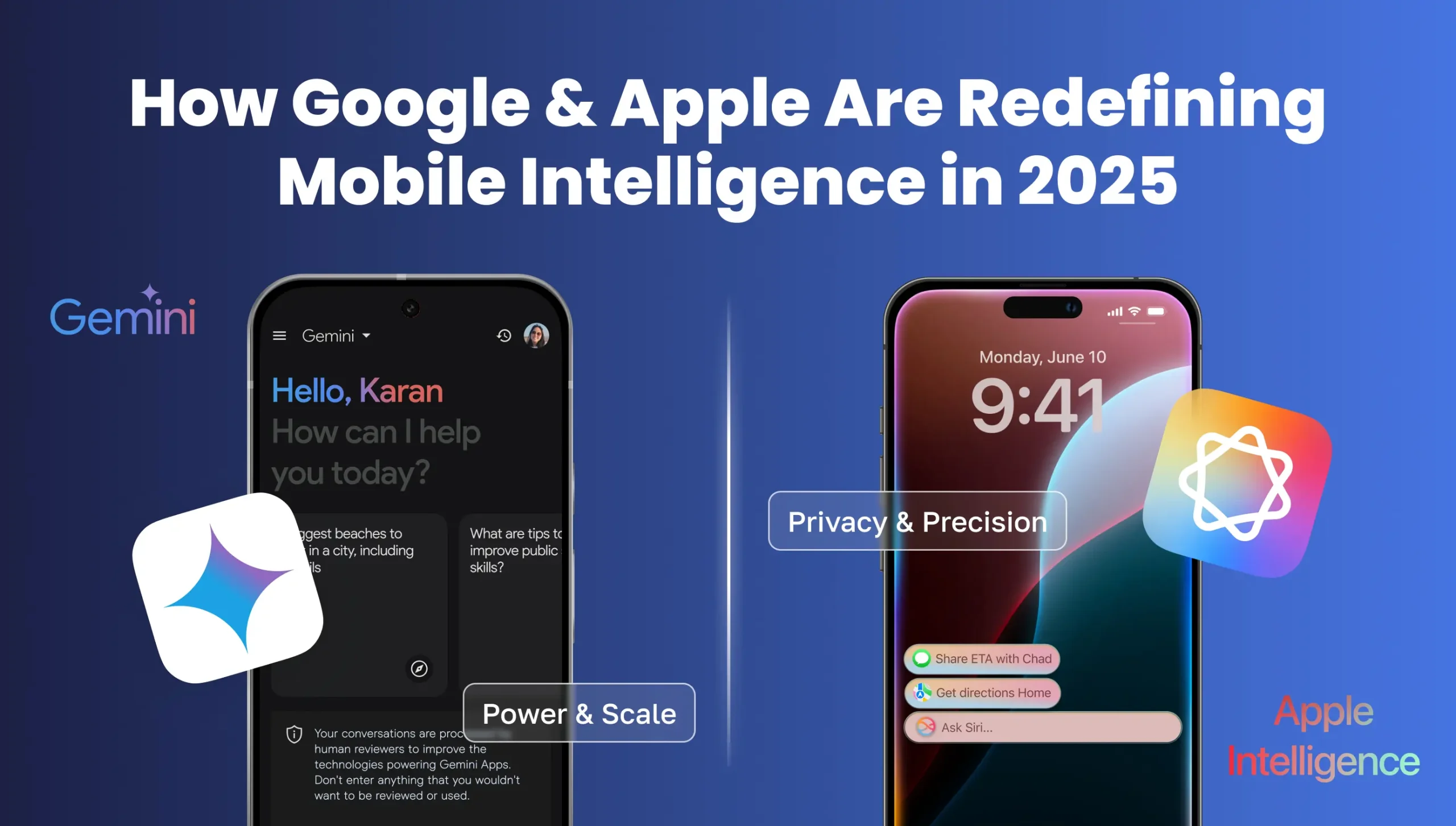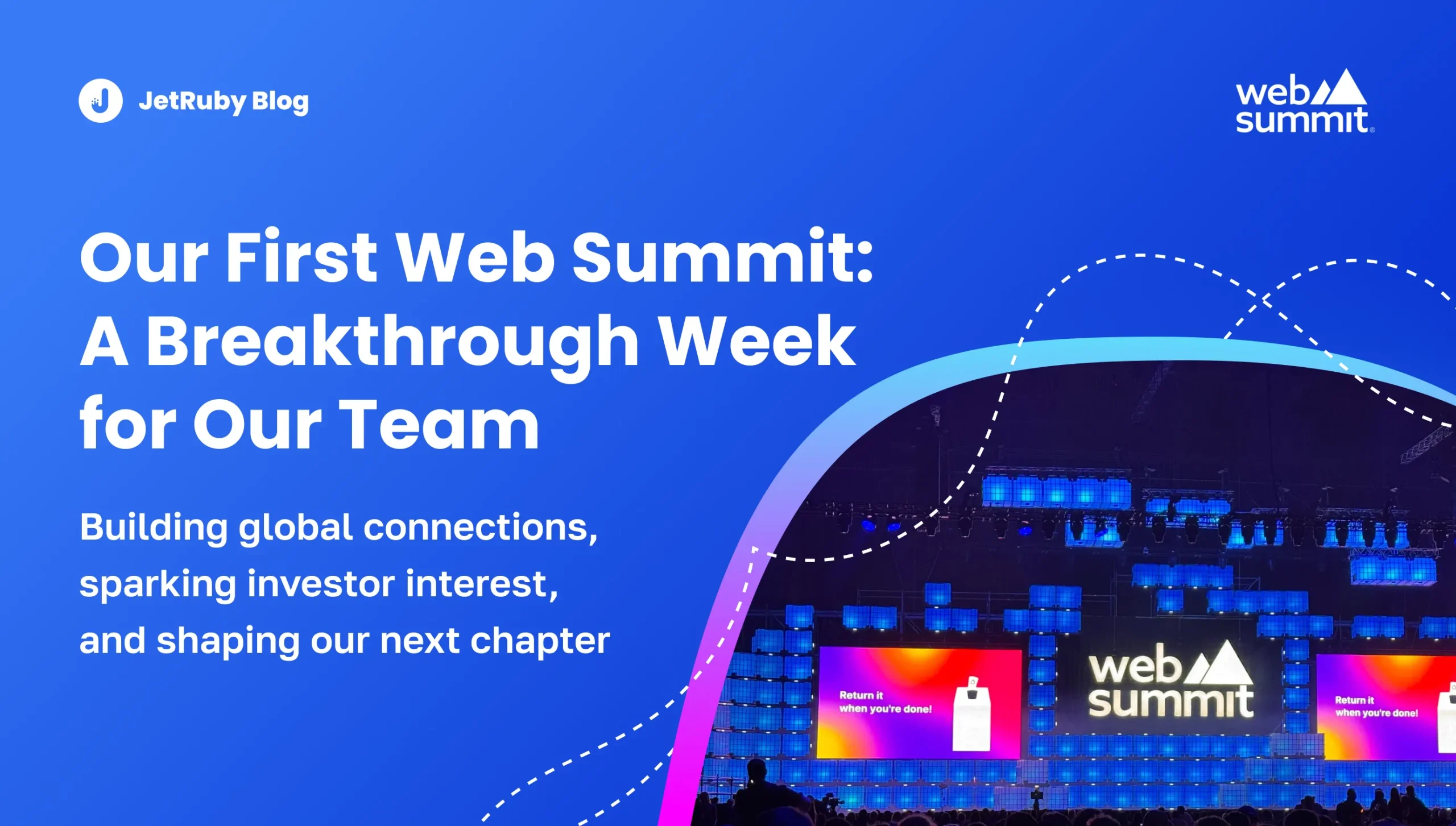Table of Contents
A Strategic Look at Two Diverging Visions of AI on the Most Personal Device in the World
Google and Apple are reshaping the AI-powered mobile experience in 2025. Where Google charges ahead with scalable, cloud-driven intelligence, such as Gemini 2.5 Pro and the ambient AI agent Astra, Apple is pursuing a tightly integrated, privacy-first path with on-device AI and a deeply reworked Siri. This article examines the underlying strategies, real-world applications, and their implications for consumers, developers, and businesses.
From Taps to Thought: 2025 Is the Year Phones Get Smart With You
Once upon a time, you told your phone what to do.
Now, it tells you what you need before you realize it.
Mobile intelligence in 2025 isn’t just about smarter queries or prettier widgets. It’s about ambient, cross-modal AI that understands your voice, vision, and context in real time. And at the forefront of this transformation are two ecosystem giants: Google and Apple.
Both companies are redefining what it means to “use” a smartphone — or a wearable — with strategies that mirror their long-standing philosophies: scale and openness for Google, privacy and vertical integration for Apple.
Let’s break down what they announced, what’s powering it, and where the real edge lies.
Google: Cloud-Powered Intelligence at Planetary Scale
Google’s announcements at I/O 2025 reinforced its position as the leader in large-scale, developer-friendly AI. At the heart of this strategy lies the Gemini 2.5 Pro, a model engineered for deep reasoning, coding, and memory-enabled problem-solving.
Gemini 2.5 Pro & Flash
Gemini 2.5 Pro brings “Deep Think”, a stepwise reasoning capability that allows it to outperform in coding tasks, math problems, and complex prompts. It’s already embedded into Workspace, Android Studio, and the Google Search experience.
Developers using Gemini Flash in Android Studio are seeing code completion speeds improve by up to 40%, with inline documentation and UI drafts generated in seconds.
AI Mode in Search: Beyond Queries, Into Conversations
Forget static lists of links; embrace the seamless integration of contextual information. The new AI Mode in Search turns questions into dynamic, personalized explorations — mixing live summaries, product comparisons, and even virtual try-ons.
As one reviewer put it, “It’s like a fusion of Google, Reddit, and a shopping assistant — curated and fast.”
Project Astra: The Assistant That Sees, Hears, and Remembers
If Gemini is the engine powered by artificial intelligence, Project Astra is the interface. It’s a multimodal, memory-capable AI assistant that listens to your environment, sees through your camera, and recalls past interactions. Think of it as a digital agent that “lives” seamlessly across your iPhone, glasses, and possibly your desktop.
Astra’s capabilities are immense — but so are the ethical implications. Continuous memory, visual scanning, and behavioral context will likely test global privacy laws in the age of AI capabilities in ways we haven’t seen since the rise of targeted advertising driven by artificial intelligence.
Veo 3 & Imagen 4: Creative Productivity at Scale
Google’s AI models aren’t just analytical — they’re generative. Veo 3 can produce HD video from text prompts, while Imagen 4 pushes photorealism and design prototyping into seconds, not hours.
YouTube Shorts and digital marketing may soon be inundated with AI-generated ad content, disrupting traditional production pipelines and prompting companies to rely on prompt engineers as key creatives.
Android XR & Smart Glasses: The Post-Screen Frontier
Google’s new Android XR platform, developed in collaboration with Gentle Monster and Warby Parker, signals a real push into wearable ambient computing. These are not bulky headsets, but elegant smart glasses with real-time Gemini integration.
With Gemini-native apps, Google might spark a post-app UI revolution — a new category of “gesture-first” and vision-enabled interfaces.
Apple: Intelligence You Don’t Have to Trust — Because It Stays With You
Where Google broadcasts power, Apple whispers confidence. Their focus is clear: deliver AI that stays on the device, integrates with native apps, and never leaks your context to the cloud — unless you explicitly allow it to do so.
Apple Intelligence SDK
Developers can now access on-device LLM capabilities, including summarization, voice logic, and image generation, without needing to ping external servers.
This opens the door for HIPAA-compliant medical tools, finance apps, and legal software that want AI features but can’t compromise data privacy.
Siri+ Gets Smarter — Quietly
The long-awaited Siri overhaul is fundamental. Now powered by an in-house large language model (LLM), Siri understands cross-app context, follows up naturally, and can execute multi-step commands. It also now handles email summarization, real-time scheduling, and voice-driven file management.
Expect deep productivity integration — Siri might become your native Zapier if it continues to evolve further.
Visual Intelligence: Quiet Power in the Camera
Apple’s Visual Intelligence offers private photo-to-data analysis: identify plants, recipes, signs, and business cards, with no server dependency.
A beta tester tweeted, “Snapped my pantry. Siri offered two complete meals using ingredients I hadn’t touched in months.”
Genmoji & Image Playground: Monetizing AI Creatively
Fun, yes — but potentially a strategic trend in AI development. With personalized emojis and visuals now native to Messages and Notes, Apple’s user experience becomes more expressive and sticky.
Insiders suggest paid Genmoji packs and AI-generated keynote slides might become new revenue channels within the Apple ecosystem.
Strategic Comparison: Power vs. Privacy
| Element | Apple | |
|---|---|---|
| Assistant | Astra (visual, memory-enabled, real-time) | Siri+ (on-device, context-aware) |
| Dev Ecosystem | Gemini API, Flash, Android Studio | Intelligence SDK (on-device only) |
| Creativity Tools | Veo, Imagen (video + photoreal AI) | Genmoji, Image Playground |
| Privacy Model | Cloud-first with opt-outs | On-device default, local inference |
| Monetization Path | Workspace, Ads, Cloud APIs | App Store+, possible Genmoji microtransactions |
As global AI regulation ramps up, Apple’s on-device approach may become the enterprise default, while Google dominates consumer creativity, content, and research flows.
What to Do Next (Based on Who You Are)
Whether you build apps, guide product vision, or want more innovative tools in your pocket, the announcements from Google and Apple aren’t just cool updates. They signal a shift in how artificial intelligence will operate , not just in a contextual manner for us.
Here’s what to consider next based on your focus:
For Developers & Tech Teams
- Choose your AI stack wisely: If you value raw AI power and fast prototyping, explore Google’s Gemini API and Flash integration in Android Studio. For privacy-focused apps (such as health, finance, and education), begin testing Apple’s on-device SDK.
- Prototype user flows for ambient interaction: Think beyond chatbot interfaces. How could voice, vision, or context create zero-friction AI in your app?
- Watch performance trade-offs: Gemini offers richer reasoning but requires cloud calls to leverage its AI capabilities fully. Apple limits depth but guarantees data control. Design with constraints in mind.
For Product Leaders & Strategists
- Reevaluate your AI feature roadmap: Apple’s LLM Siri upgrade and SDK will rapidly shift iOS user expectations. Google’s Astra pushes expectations for real-time assistance. Align your UX to match.
- Prepare your product for AI-led discovery, leveraging AI capabilities: Google Search’s AI Mode changes how users discover, compare, and convert. Rethink your presence in AI-curated experiences — not just SEO.
- Consider the regulatory angle now: If your roadmap includes user-generated content, visual data, or cross-device assistants, anticipate responses to GDPR, DMA, and U.S. privacy laws.
For Marketers & Brand Builders
- Create assets for AI summarization: Traditional SEO snippets may lose visibility. Focus on well-structured, AI-friendly content is essential for effective communication with СhatGPT.
- Optimize your content for answers, not just traffic: Expect Google and Apple AI interfaces to extract summaries, lists, and comparisons from your content. Structure messaging accordingly.
- Watch AI-native channels emerge: Gemini-powered content assistants and Siri’s integration into Notes, Messages, and Mail could become new surfaces for branded influence.
For Everyday Users & Power Consumers
- Decide what you want in an assistant: Do you prioritize advanced features (Google) or privacy-by-design (Apple)? The ecosystem you choose in 2025 could shape your digital autonomy.




